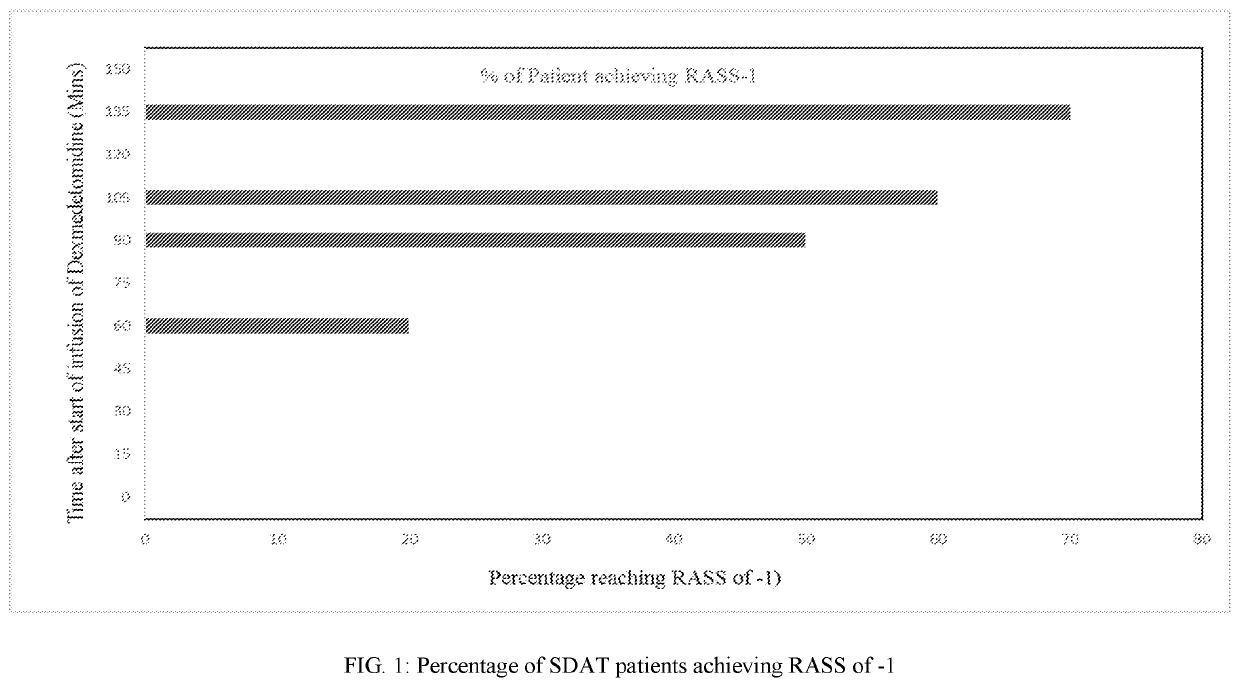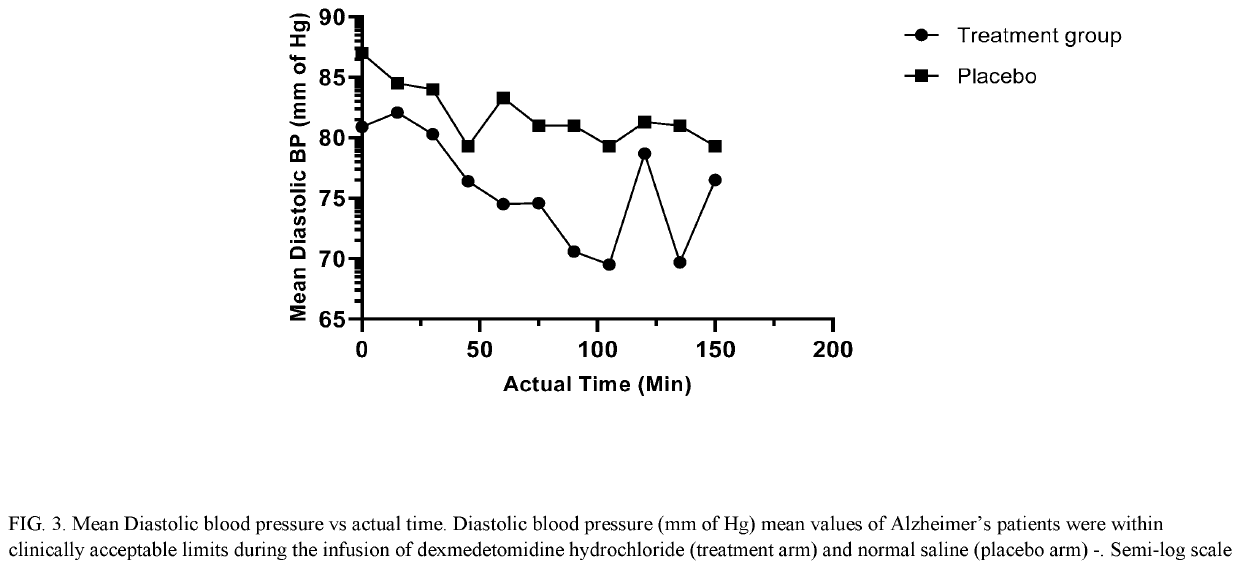Methods for treating agitation using dexmedetomidine hydrochloride
a technology of dexmedetomidine and hydrochloride, which is applied in the direction of nervous disorders, pharmaceutical delivery mechanisms, medical preparations, etc., can solve the problems of drug development tolerance and physical dependence, and the association of haloperidol with extrapyramidal side effects, etc., to reduce agitation or signs of agitation
- Summary
- Abstract
- Description
- Claims
- Application Information
AI Technical Summary
Benefits of technology
Problems solved by technology
Method used
Image
Examples
example 1a
Dosing of Dexmedetomidine Hydrochloride in a Middle-Aged to Elderly Cohort of Subjects
[0150]Dose escalation was performed by infusing 0.1 mcg / kg / hr to 0.6 mcg / kg / hr of dexmedetomidine hydrochloride intravenously over 30 min. Subjects in the initial cohorts were initially healthy, elderly (55-75 years of age) volunteers. Subjects in later cohort were elderly volunteers healthy except for having mild probable SDAT. Both sexes were included in all cohorts.
[0151]In the first cohort, dexmedetomidine hydrochloride was administered by IV infusion over a dose range from 0.1 mcg / kg / hr to 0.6 mcg / kg / hr. Each infusion rate was administered for 30 minutes. After 30 minutes, the dose was increased by an additional 0.1 mcg / kg / hr until the subject achieved a predetermined level of sedation as assessed by the Richmond Agitation-Sedation Scale (RASS) or a pre-specified reduction in BP and / or HR. The dosing rate was adjusted for subsequent cohorts based on the results of preceding cohorts. Continuous...
example 1b
[0157]IV Dexmedetomidine Hydrochloride for Treating Acute Agitation in Patients with Senile Dementia of the Alzheimer's Type (SDAT)
[0158]We determined the optimal IV dose and safety profile of dexmedetomidine hydrochloride in the target population to achieve a RASS score of −1, how long the mild sedative effect persists after discontinuation of study drug administration, whether neurological effects like cognitive functioning, alertness / awareness, balance, and reaction time persist after the mild sedative effect has resolved, and whether any adverse effects on blood pressure, heart rate, or respiratory drive occurs before or coincident with the achievement of the aforementioned level of sedation.
[0159]This was a randomized, blinded, prospective, placebo controlled, parallel design, single centre, investigator-initiated study conducted to evaluate the efficacy and safety of dexmedetomidine hydrochloride in agitated subjects with senile dementia of Alzheimer's type (treatment allocati...
example 2
[0196]IV Dexmedetomidine Hydrochloride in Subjects Suffering from Schizophrenia
[0197]The Primary Objective was to determine the optimal intravenous (IV) dose of dexmedetomidine hydrochloride in the target population in terms of efficacy and safety to achieve arousable sedation (RASS of −1) which can be reversed by verbal stimulation. When this goal was achieved in each participant, the IV infusion of dexmedetomidine hydrochloride ceased.
[0198]In addition, we assessed the following Secondary Objectives:[0199]a. Determine how rapidly the drug can be administered up to the total dose needed to achieve RASS −1.[0200]b. Determine how long the calming effect persists after discontinuation of study drug administration.[0201]c. Determine whether any adverse effects on blood pressure, heart rate, or respiratory drive occurs before or coincident with the achievement of Primary Objective. Stopping rules for blood pressure and heart rate, indicating a clinically significant event, are:[0202]1. ...
PUM
| Property | Measurement | Unit |
|---|---|---|
| Fraction | aaaaa | aaaaa |
| Time | aaaaa | aaaaa |
| Concentration | aaaaa | aaaaa |
Abstract
Description
Claims
Application Information
 Login to View More
Login to View More - R&D
- Intellectual Property
- Life Sciences
- Materials
- Tech Scout
- Unparalleled Data Quality
- Higher Quality Content
- 60% Fewer Hallucinations
Browse by: Latest US Patents, China's latest patents, Technical Efficacy Thesaurus, Application Domain, Technology Topic, Popular Technical Reports.
© 2025 PatSnap. All rights reserved.Legal|Privacy policy|Modern Slavery Act Transparency Statement|Sitemap|About US| Contact US: help@patsnap.com



